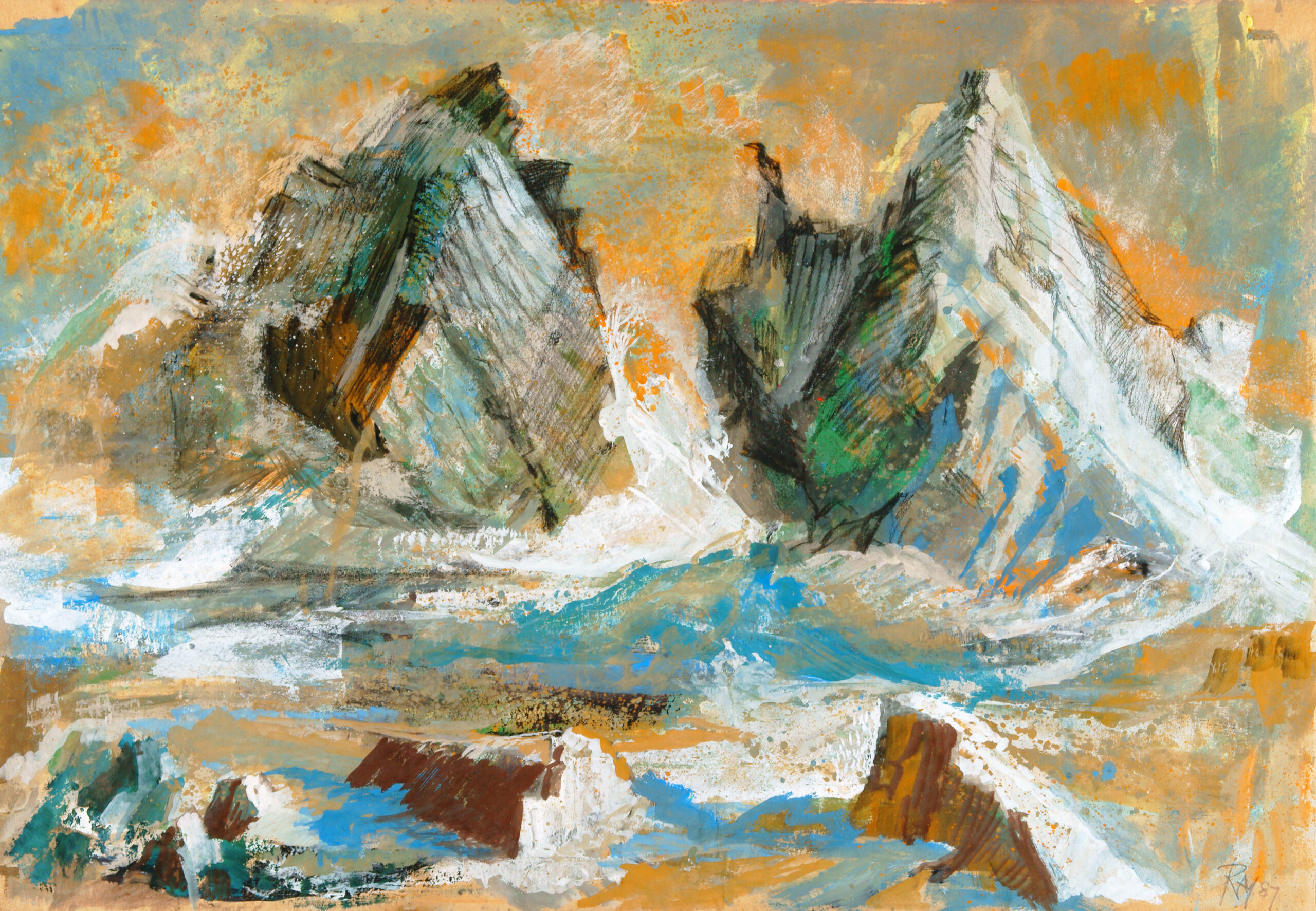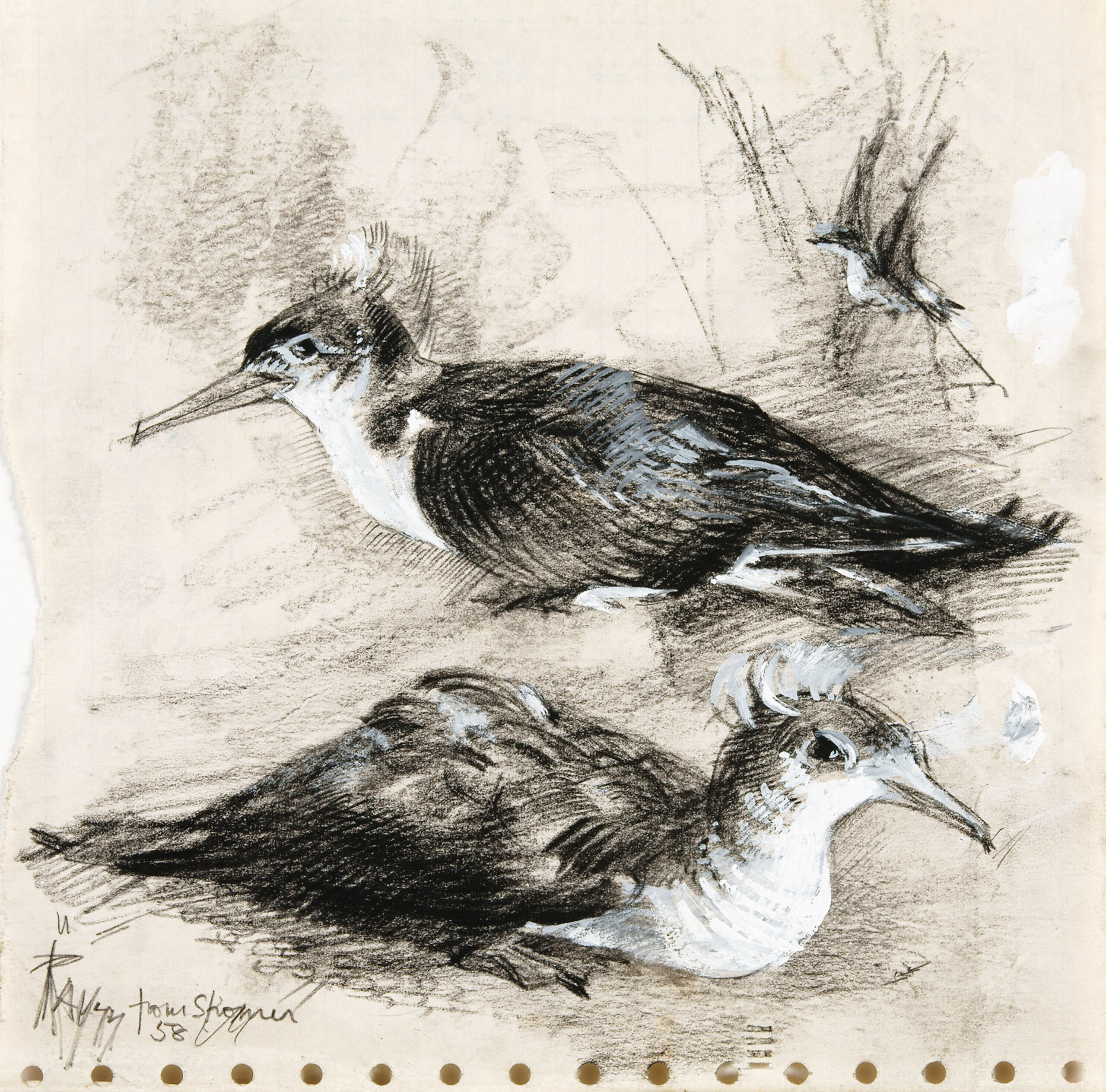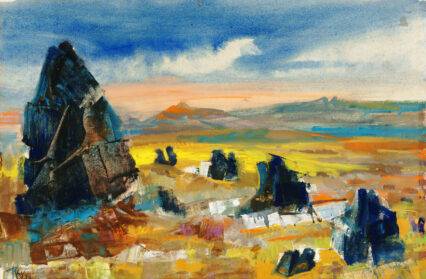In an exclusive extract from his new book, My Hand is the Voice of the Sea, David Moore explores the divine inspiration of the work of Ray Howard-Jones at a time of reappraisal for the West Wales artist.
I first encountered the work of Ray Howard-Jones in 1983 at The National Library of Wales, Aberystwyth, during a touring retrospective exhibition with West Wales Arts. Two years later I started work with Pembrokeshire Museum Service and realised that the artist was a local celebrity.
The curator, Robert Kennedy, had supported her with two substantial exhibitions in the 1970s and the museum’s collection included several of her paintings. Intrigued, I visited her 1985 exhibition at Nashdom Abbey and bought a drawing, Young Shearwaters by the Pond, and a gouache, Carn Meini. It was late autumn 1987 that I learned that the artist, then in her eighties, was seeking someone prepared to drive her to London in her own vehicle after a season of painting at Martin’s Haven. Robert wondered whether I might be interested and, before realising what was involved, I had been volunteered. I would, eventually, drive her back to London four times. This was usually in November and, for the last time, in 1991. Only later did I discover that others had supported her in the same way. Ray was remarkably adept at persuading people, particularly men, to help her.

These trips were not without incident. Ray’s vehicle, at first a Citroën van and, later, a car, would be tightly crammed with paintings and equipment. Frequent comfort stops for refreshments were necessary on the motorway.
I vividly remember, while we took a tea break at Aust Services on the M4, Ray sketching the Severn suspension bridge in ballpoint pen on a paper napkin. Another journey was even more memorable. The alternator dropped out while we sped along the motorway. I recall the metallic clinking sound as it leapt like a bouncing bomb along the road behind us. The AA towed us to a nearby garage and, in bitter cold, we sat huddled around a kerosene burner while mechanics investigated. In the end we had to be taken to London by breakdown vehicle. I sat next to the driver while Ray slept in the back.
I was intrigued by the state of Ray’s Victorian Italianate house in Chiswick. Not furnished like a conventional home, it was bursting with possessions piled high and chaotically in every room – clothes, art materials, objets trouvés, books, papers, paintings, photographs and pot plants. Without these contents it would have been spacious. A large bed was just discernible in the living room downstairs. The back garden had a wild, overgrown appearance.
I had never encountered anyone quite like Ray. About five and a half feet in height, this sprightly fair-haired woman in her mid-eighties with inquisitive blue eyes was feisty, focused, driven and unconventional. Engaging in conversation she was rarely reserved in expressing an opinion. She was totally convinced of her own worth and destiny. I had been told that she could be difficult to work with. Only later would I come to realise that she had endured life-changing physical disabilities and personal setbacks and that her Christian faith was of great significance to her.
On occasions during the summer and autumn, when Ray was living in a caravan at Martin’s Haven, I visited her. This would usually be in the evening after she had spent a day sketching and painting on the coast. Brewing herbal or rosehip tea on a gas camping stove in the shed she used as a studio, she would, much to my consternation, offer me strange-looking capsules which contained garlic. She would talk about people she knew and had known, about her work, the light and colour of the coast, about how several lifetimes would not be long enough to do all the things she would like to do and, with conviction, the significance of her work.
I heard dramatic and expansive accounts of Ray’s activities from her elderly Dutch friend Joanna Van Driel. Also a friend of mine, a near neighbour met through the museum friends, Joanna lived in a bungalow in Crundale, north of Haverfordwest, and regretted leaving her former home on a cliff overlooking Nolton Haven. While Ray’s retrospective exhibition was being shown at the town’s circular library gallery in 1983 Ray had taken over Joanna’s front bedroom, bringing considerable chaos.
Even late in life, Ray stayed at Martin’s Haven as late in the year as possible, often braving severe storms. Mary John from the library service sometimes drove me down to Martin’s Haven for the start of the journey to London. On at least one occasion a strong gale was blowing and loading the car was extremely difficult.

I had become familiar with many more of Ray’s paintings at the West Wales Art Centre in Fishguard which was run by Myles Pepper. By the early 1990s she had become involved with David and Jonathan Stephenson of the Rocket Press and they promoted her work in London. I attended a crowded exhibition launch in Cork Street in 1993 at which Ray was the centre of attention. The previous year I had moved to Brecon as curator of Brecknock Museum where I established a programme of exhibitions by modern and contemporary Welsh artists. In 1994, in association with Rocket, the museum showed Ray’s late seascapes. She was brought to the launch, opened by her friend Roger Worsley, a writer and radio broadcaster from Pembrokeshire. Although she stayed two nights in Brecon, she found the trip exhausting. It was, I understand, her last visit to Wales.
Much later I became interested in researching and writing about Ray’s work and gradually accumulated information. Only in more recent years was I able to find the time to work in a more focused way on the project. This has been challenging. Not only did Ray, who died in 1996 aged ninety-three, leave a considerable quantity of artwork ranging from the highest quality to the briefest of sketches, but she also left a large personal archive. She bequeathed most of her studio collection of what was to become 1,800 catalogued works, including many sketchbooks, to the National Museum of Wales.
Most of her archival material was passed to the care of The National Library of Wales. While the basic threads of Ray’s life and work are known, much of the richness and complexity of it has taken many years to establish. Particularly in her later years Ray corresponded with a wide range of people, keeping hand-written copies of much of her correspondence. I have also received considerable help from individuals.
The dating of Ray’s artworks has not always been easy. There have been instances when Ray has, often decades later and with the fallibility of memory, attempted to date works retrospectively. By studying sketchbooks and archives, discrepancies have sometimes emerged between dated work, even locations, and documentary evidence. In this respect it has proved useful to become familiar with the evolving character of her signature.
Ray’s lively letters and extensive personal writings have been an invaluable source of information. These have been drawn upon to give her a voice in the story. Sometimes she wrote rather disjointedly, more of an assemblage of thoughts than a coherent narrative. It seems likely that she was, in some way, dyslexic and her school reports for poor spelling might suggest this. Indeed, she recognised in later life that she had a largely visual memory. Nevertheless she had a strong desire for poetic expression, often revealed in her titles, and her poetry provides considerable insight into the Christian mysticism that is implicit in much of her later artwork.
Another aspect of Ray’s writing and conversation that I do not wish to over emphasise but which needs to be acknowledged was an endearing tendency, particularly in later years, to embellish certain achievements and even to indulge in a little personal myth-making. Whenever possible I have sought corroborative evidence to support the occasional disputable statement.
The illustrated biography is an attempt to provide an overview of Ray’s life and art, to reveal an artist who, while remarkably driven, has been overlooked in recent years and, often, greatly misunderstood. She has, undoubtedly, suffered three-fold through neglect of women artists, predominantly figurative artists and Welsh artists. Taken as a whole, her work also eludes neat categorisation. Despite great self confidence her profound Christian faith ensured that, in her eyes, the work never fully lived up to the wonders of God’s creation.
Ray Howard-Jones: My Hand is the Voice of the Sea by David Moore is published by Bird Eye Books (an imprint of Graffeg)
[Header image: Carn Mein by Ray Howard-Jones]












